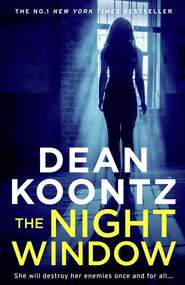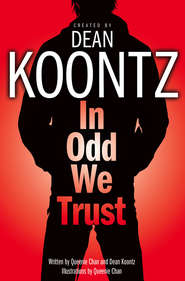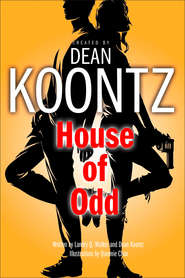По всем вопросам обращайтесь на: info@litportal.ru
(©) 2003-2025.
✖
77 Shadow Street
Автор
Год написания книги
2019
Настройки чтения
Размер шрифта
Высота строк
Поля
If Bailey had been more prudent than curious, he would have snared his thick terry-cloth robe from the hook on which it hung, slipped into it and his flip-flops, and hurried to the nearby security room in the west wing of the basement. Devon Murphy would be on duty there. But Bailey was transfixed by the eerie nature of the swimmer, by the otherworldly mood that settled on the room.
The building shuddered ever so slightly. A low rumble rose from the earth under the Pendleton’s foundation, and Bailey glanced at the floor in front of him, half expecting to see hairline cracks opening in the mortar joints between the tiles, though none did.
With the brief shaking, the light in the pool changed again, from the pustulant shade of disease-darkened urine to red. Short of the steps, the swimmer turned with the serpentine ease of an eel, heading back toward the end of the pool from which Bailey had fled.
Where clear, the water was the color of cranberry juice. Where clouded as if from disturbed silt, it resembled blood, and that vile stain now spread more rapidly through the pool.
The fluttering watery reflections on the glossy white tiles of the walls and ceiling morphed into tongues of faux fire. The long room grew dimmer, murkier, and shadows swelled like billowing smoke.
Nearing the farther end of the lap pool, the swimmer became harder to see, although still visible in the fouled water. No man could have swum three lengths so quickly without once needing to surface for a breath.
The shuddering lasted five or six seconds, and half a minute after it subsided and after the building grew silent, the pool lamps phased from red to yellow to white again. The faux fire licking along the glossy walls became dancing wings of light as before, and the room brightened. The cloudy water turned crystalline once more. The mysterious swimmer had vanished.
Bailey Hawks stood with his hands fisted at his sides, dripping into the puddle in which he stood. His heart knocked with less force than it might have when he was under enemy fire, back in the day, but never the less hard enough for him to hear it hammering.
Chapter 4 (#ulink_e4ba521c-0245-5f81-9407-545c9d42bfcb)
Apartment 3–C
At 4:13 A.M. Silas Kinsley was awakened by a low thunderlike sound and thought the building seemed to be shaking. But the brief rumble and the movement stopped by the time that he sat up and came fully to his senses. He waited in darkness, listening for a moment, and then decided that the disturbance had been part of a dream.
When he lowered his head to the pillow once more, however, a sound arose from within the wall against which his bed stood. The whispery slithering noise brought to mind images of snakes writhing between the studs behind the plasterboard, which seemed improbable if not impossible. He had never before heard anything like it. He suspected—intuited—that it must be related to the disquieting history of the house.
The disturbance continued for perhaps five minutes. He lay listening, wondering, not fearful but certainly wary and alert for any change in the sound that might help him to identify the cause.
The subsequent silence was the expectant kind that fostered insomnia. Having recently turned seventy-nine, he usually found sleep elusive once it had been interrupted. Silas was a retired civil-litigation attorney, but his mind hummed as busily these days as when his calendar had been fully booked with clients. He rose before dawn, showered, dressed, and was frying eggs in butter when, beyond the kitchen window, the hot-pink light of morning painted coral reefs across the sky.
Later, after lunch, he fell asleep in an armchair. When he sat up in alarm an hour later, he could not recall much of the nightmare from which he had fled, only that it involved catacombs of flowstone, in which there were no skeletal remains, as in most catacombs, but empty burial niches carved into the sinuous walls. Something silent and unseen, something with implacable intent, had sought him through that maze of passageways.
His hands were as cold as those of a corpse. He stared at the rising moon at the base of each of his fingernails.
Still later on that somber December afternoon, Silas stood at a living-room window of his third-floor apartment in the Pendleton, on the crown of Shadow Hill, watching the lower avenues fade behind an advancing wall of rain. Buildings of buff brick, of red brick, of limestone, as well as newer and taller and uglier curtain-glass towers were at once bleached to a uniform gray as the storm washed over them, becoming like the ghostly structures of a long-dead city in a dream of plague and desolation. Neither the warm room nor his cashmere sweater could relieve the chills that, like a winged horde, fluttered through him.
The official story was that, 114 years earlier, Margaret Pendleton and her children—Sophia and Alexander—had been snatched from this house and murdered. Silas had come to doubt that the long-ago kidnapping occurred. Back in the day, something stranger than murder happened to those three, something worse.
Shadow Hill rose to the highest point in this heartland city, and the third floor was the Pendleton’s topmost. The west-facing structure seemed to rule the rain-swept metropolis below. Both hill and street were named for the shadows of trees and buildings that, on a sunny afternoon, grew longer by the hour until, at twilight, they crept to the summit and met the night as it came in from the east.
Not just a great house, not merely a mansion, the Pendleton was more accurately a Beaux Arts palace built in 1889, at the height of the Gilded Age, sixty thousand square feet under roof, not counting the vast basement or the separate carriage house. A combination of Georgian and French Renaissance styles, the building was clad in limestone, with elaborately carved window surrounds. Neither the Carnegies nor the Vanderbilts, nor even the Rockefellers, had ever owned a grander house.
Upon taking up residence shortly before Christmas 1889, Andrew North Pendleton—a billionaire in an era when a billion dollars was still real money—christened his new house Belle Vista. And so the place was known for eighty-four years; but in 1973, it was converted into condominium units and renamed the Pendleton.
Andrew Pendleton remained happy in Belle Vista until December 1897, when his wife, Margaret, and their two young children were supposedly abducted and never found. Thereafter, Andrew became a pitied recluse whose eccentricity matured into a genteel kind of madness.
Silas Kinsley had lost his wife in 2008, after fifty-three years of marriage. He and Nora were never blessed with children. Having been a widower for three years, he could imagine how loneliness and grief might have robbed Andrew Pendleton of his sanity.
Nevertheless, Silas had concluded that loneliness and loss were not the primary causes of the billionaire’s long-ago decline and suicide. Andrew North Pendleton had been driven insane also by some terrible knowledge, by a mysterious experience that he struggled to understand for seven years, on which he remained fixated until he took his own life.
A kind of fixation had gripped Silas, too, following Nora’s death. After selling their home and buying this apartment, he had filled his time by taking an interest in the history of this landmark building. That curiosity ripened into such an obsession that he spent uncounted hours poring through public records, back issues of newspapers more than a century old, and other archives in search of facts, no matter how ordinary, that might add to his knowledge of the Pendleton.
Now, although he had watched the legions of the storm marching out of the lowlands and up the long north slope of Shadow Hill, Silas startled back one step when the first wet volley snapped against the French panes, as if the rain, mistaken for mere weather, were instead a malevolent assault aimed specifically at him. The city blurred, the day seemed to darken, and the silvering effect of the living-room lamplight made an inadequate mirror of the window. In the wet glass, his face was transparent and lacking sufficient detail, as if it were not in fact his reflection but instead must be the face of another, the pale countenance of something less than fully human, a visitor from an occult realm temporarily connected to this world by the power of the storm.
Spikes of lightning split the darkening day, and Silas turned away from the window as thunder jackhammered the sky. He went to the kitchen, where the under-cabinet fluorescents brightened the golden-granite countertops and where all other lights were off. His files about the Pendleton littered the dinette table: newspaper articles, Xeroxes of public records, transcripts of interviews with people who claimed to have some experience of the building prior to 1974, and photocopies of the eleven scraps that remained of a handwritten journal that Andrew North Pendleton had destroyed immediately before killing himself.
Each surviving piece of Pendleton’s writing was an incomplete fragment, each singed brown around the edges because he burned the journal in his bedroom fireplace prior to biting a shotgun barrel and receiving a mortal meal of buckshot. Each of the eleven scraps of prose was intriguing, suggesting that Andrew Pendleton endured an experience so extraordinary as to be otherworldly. Or perhaps in the final stages of his madness, he was tormented by a dementia in which he mistook nightmares and hallucinations for memories of real events.
Of the eleven surviving scraps, Silas most often returned to a cryptic, disturbing fragment about Pendleton’s daughter, Sophia, who was seven years old when she disappeared. The words and all their possible meanings so haunted him that he’d committed them to memory: … and her once-pink skin gone gray, her lips as gray as ashes, and her eyes like smoke, a humorless and iron-gray grin, no longer my Sophie and less Sophie by the moment.
Andrew Pendleton’s loss of his family was not the only tragedy in the history of the great house. The second owner, Gifford Ostock, who was the sole heir to considerable wealth made in coal mining and in railroad coal-car manufacturing, lived well and fully in Belle Vista from 1905 until 1935. One night in December of ’35, the butler, Nolan Tolliver, slaughtered the Ostock family and all the live-in staff before killing himself. Tolliver left an incoherent handwritten note claiming to have murdered them in order to “save the world from eternal darkness,” and though he took responsibility for all sixteen killings, eight of the dead were never found. To this day it was not known why or how Tolliver disposed of half his victims, or why he did not likewise dispose of the other eight.
Chapter 5 (#ulink_32053fc3-a58a-5b11-8a84-de3e53fff473)
Apartment 2–C
Bailey Hawks had not reported the encounter in the lap pool to building security. Out of consideration for the privacy of residents, no camera was mounted in that room; therefore, no proof existed that the bizarre incident had occurred.
Five residents of the Pendleton were among his clients: the Cupp sisters, Edna and Martha, in 3-A; Rawley and June Tullis in 2-D; and Gary Dai in 3-B. People with substantial investment portfolios were not likely to continue to entrust their assets to a man who began to rant about a supernatural experience, regardless of how solid his performance had been in the past.
Bailey spent most of the morning and early afternoon in his study, where he tracked the prices of stocks, bonds, and commodities on three dedicated computers while conducting research and analysis on a fourth. Only one of his two full-time employees, Jerry Allwine, worked here with him, and although Jerry was out with the flu, the day was not hectic. There wasn’t much movement in either equities or commodities, and when the major exchanges closed, at 2:00 his time, it proved to be a treading-water day.
Normally, Bailey possessed a sharp focus and singular powers of concentration, which served him as well on financial battlefields as in the wars in Afghanistan and Iraq. As he worked that Thursday, however, his mind repeatedly drifted to the memory of the mysterious figure in the pool, and the sense of peril that he had felt back in the moment rose anew and lingered, though not as acute as it had been during the encounter.
Computers off, working by the light of a single lamp, he was still at his desk past three o’clock when shatters of rain against the north-facing windows drew his attention. For the first time he realized how dark the day had grown. Dusk had crept in two hours ahead of schedule. The lowering clouds were as plush and gray as the coats of the Cupp sisters’ cats, seeming not only to belly over the city but also to curl around it as if settling in for a long dreamy evening.
Serial lightning flashed, flashed, flashed. The bright flares caused geometric shadows of the French-window muntins and stiles to flutter through the dimly lighted room and briefly print themselves upon the walls.
The quick-following crash of thunder, loud enough to suggest Armageddon, did not bring Bailey up from his chair. But as his desk lamp dimmed, he bolted to his feet during the subsequent barrage of lightning because this time, among the flung grids of window-frame shadows, another shadow moved. Sinuous and fleet. It raced across the room not as if it might be a silhouette of something inanimate projected and set in motion by the storm light, but instead as if it must be an intruder revealed.
Man-tall when it leaped, the featureless dark figure seemed more pantherlike as the leap became a lower lope. Having spun in his chair even as he sprang up from it, Bailey turned to follow the specter, if that’s what it was. The thing eluded the eye, swift and quicksilvery, its motion smooth and continuous while the lightning-inspired shadows of the window frames flickered and twitched in the stroboscopic pulses of the storm.
The black form didn’t print itself upon the wall, along with the window grids, but seemed to pass through the plaster. The chain of lightning cast out its last bright link, the brass desk lamp grew brighter, and Bailey hurried from the study in pursuit of the thing that walls could not contain.
Chapter 6 (#ulink_99df6256-0f1b-5a7c-80d3-f859e5245535)
Apartment 3–C
After he stood staring for a moment at the Pendleton-related files on the kitchen table, Silas went to the coffeemaker. He filled a white ceramic mug and took down a bottle of brandy from a cupboard shelf and spiked the coffee. The clock showed 3:07 P.M., and though Silas never took a drink earlier than dinnertime, if at all, he felt the need to be fortified for a meeting at five o’clock.
He leaned against the counter, with his back to the double sink and to the window above it. Lightning flared, enlivening his shadow, which sprang forward and leaped back through the half-dark kitchen, forward and back again, as if the distorted silhouette were an entity with a mind of its own and with a keen desire to be free of him.
He sipped the coffee, which was as hot as he could tolerate, perhaps a cure not just for his unsteady nerves but also for the chills that plagued him. He was of half a mind to skip his scheduled meeting, to remain here and drink spiked coffee until his eyes grew heavy and he could no longer stay awake. Even in retirement, however, he was a lawyer who respected not just federal, state, and city laws, but also and primarily natural law, the code with which he believed that all men were born, a code of responsibilities that included the duty to love truth and always to pursue it.
Sometimes truth was elusive …
After Tolliver, the butler, murdered the Ostock family and his fellow workers in 1935, Belle Vista stood empty for three years, until a bachelor oilman named Harmon Drew Firestone, undeterred by the history of violence, purchased the great house at a bargain price. He spent a fortune to restore it to its former grandeur. By World War II, Belle Vista had become the center of the city’s vibrant social scene. Old Harmon Firestone died quietly in his sleep, of natural causes, in the spring of 1972.
Firestone’s estate sold Belle Vista to a property-development trust that converted the building into twenty-three condominium apartments of various sizes. The high ceilings, the lavish and well-crafted architectural details, the hilltop views, and the elegant public spaces ensured that the units sold out quickly in 1974, for the highest per-square-foot cost in the history of the city. Thirty-seven years later, a couple of the original owners still lived in their apartments, but other units had changed hands more than once.
Only the previous day, Silas learned that the Pendleton’s history of bloodshed didn’t end in 1935, with Nolan Tolliver’s killing spree. Not only had there been more recent violence of a bizarre nature; apparently, the incidents also occurred with a predictable regularity, every thirty-eight years, give or take a day, which suggested that another atrocity might occur soon.











